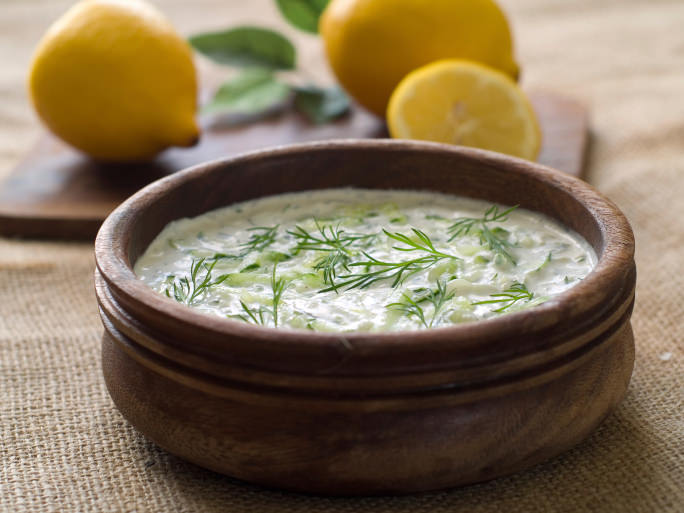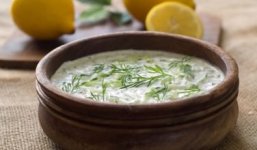Tztaziki is one of the easiest recipes to make and its so tasty and great for dipping crackers, bread, or veggies! You need to start with Greek strained yogurt that super thick and then add one clove of garlic, two tablespoons of olive oil, two large spoonfuls of shredded and strained cucumber, the juice of one lemon, and salt and pepper to taste. Depending on where you get your ingredients from, you might need to adjust the recipe to your taste. Happy cooking!
Menu
Install the app
How to install the app on iOS
Follow along with the video below to see how to install our site as a web app on your home screen.
Note: This feature may not be available in some browsers.
You are using an out of date browser. It may not display this or other websites correctly.
You should upgrade or use an alternative browser.
You should upgrade or use an alternative browser.
Greek Food, Cooking and Recipe Community
How to make fresh and zesty tzatziki!
- Thread starter toniiv
- Start date
1 - 4 of 4 Posts
Here is a good recipe for Tzatziki:

 www.greekboston.com
www.greekboston.com


Greek Tzatziki Sauce Recipe
Tzatziki is the quintessential Greek dipping sauce. The recipe for tzatziki is actually very simple and goes great with grilled meats!

Hash
Well-known member
Nice!....Here is a good recipe for Tzatziki:

Greek Tzatziki Sauce Recipe
Tzatziki is the quintessential Greek dipping sauce. The recipe for tzatziki is actually very simple and goes great with grilled meats!www.greekboston.com
View attachment 914
k_tsoukalas
Administrator
I love making my own tzatziki. Thank you for sharing the recipe! I find that I love this with the authentic, creamy Greek yogurt, and if I can't find that, I strain regular yogurt through a cheesecloth. However, I don't prefer the strained version necessarily because it has a different flavor.
1 - 4 of 4 Posts
JOIN THE DISCUSSION AND READ OTHER GREEK INFO:
How to learn about different regional cuisines in Greece?
- toniiv
- Greek Food Forum
- Replies: 1
I have learned so much about Greek cuisine by being on this forum! I know that there are standard recipes that everyone seems to cook.
For example, you can get souvlaki all over. Everyone seems to serve a village salad with slight variations. Most regions seem to make moussaka. There are tons of others.
I have also noticed that each region has their own specialties. How do you go about learning about them?

For example, you can get souvlaki all over. Everyone seems to serve a village salad with slight variations. Most regions seem to make moussaka. There are tons of others.
I have also noticed that each region has their own specialties. How do you go about learning about them?

Different kinds of baklava to try?
- acamp7
- Greek Food Forum
- Replies: 0
I've recently found myself on a delicious quest to explore the world of baklava, that rich, sweet pastry made of layers of filo filled with chopped nuts and sweetened with honey or syrup. I understand that baklava has roots in many culinary traditions across the Middle East, Eastern Europe, and Central Asia, each bringing its own unique twist to this iconic dessert.
From what I’ve gathered, the variations of baklava are as numerous as they are delicious, differing in nuts, spices, types of syrup, and preparation methods. However, navigating through these variations is quite the challenge, and that’s where I’m seeking your collective wisdom!
I am curious what you guys think!
From what I’ve gathered, the variations of baklava are as numerous as they are delicious, differing in nuts, spices, types of syrup, and preparation methods. However, navigating through these variations is quite the challenge, and that’s where I’m seeking your collective wisdom!
I am curious what you guys think!
Getting souvlaki tender?
- nadellii
- Greek Food Forum
- Replies: 0
How do you make tender Greek souvlaki? I've attempted various recipes, marinated for different durations, and experimented with both high and low cooking temps, but I seem to be missing the mark for that mouth-watering tenderness commonly found in authentic Greek souvlaki.
Has anyone found a particular method or ingredient that makes a significant difference in achieving that ideal tenderness?
I use ladolemono, a marinate it overnight in ziplock baggies (after I cut the meat in cubes) and then I add them to the skewers and cook them on the grill. I typically use chicken.
Has anyone found a particular method or ingredient that makes a significant difference in achieving that ideal tenderness?
I use ladolemono, a marinate it overnight in ziplock baggies (after I cut the meat in cubes) and then I add them to the skewers and cook them on the grill. I typically use chicken.
No Meat Dolmades (Stuffed Grape Leaves) Recipe
- ssherie_
- Greek Food Forum
- Replies: 0
It has taken me a long time to get vegetarian dolmades to the point where I enjoy them. Here is my recipe. It uses a lot of oil, so strict fasters shouldn't eat them. But most people aren't super strict so I would even say these are good for lent!
Ingredients:
- 1 jar of grape leaves (about 60-70 leaves)
- 1 cup short-grain rice
- 1 large onion, finely chopped
- 2 cloves garlic, minced
- 1/2 cup chopped fresh dill
- 1/2 cup chopped fresh mint
- 1/2 cup chopped fresh parsley
- 1/4 cup olive oil, plus extra for drizzling
- Juice of 2 lemons
- Salt and pepper to taste
- Water
Instructions:
- Prepare the Grape Leaves:
- If using grape leaves preserved in brine, rinse them well under cold water to remove excess salt. If using fresh grape leaves, blanch them in boiling water for about 1 minute, then drain and rinse with cold water. Trim off any stems.
- Prepare the Filling:
- In a large bowl, combine the rice, chopped onion, minced garlic, chopped dill, chopped mint, chopped parsley, olive oil, lemon juice, salt, and pepper. Mix well to combine.
- Fill and Roll the Grape Leaves:
- Place a grape leaf flat on a clean work surface, shiny side down, with the stem end facing you. Spoon about 1 tablespoon of the rice filling onto the center of the leaf, near the stem end.
- Fold the bottom of the leaf over the filling, then fold in the sides, and roll tightly into a small cylinder.
- Repeat with the remaining grape leaves and filling, arranging the rolled dolmades seam-side down in a large pot or deep skillet, packing them snugly together.
- Cook the Dolmades:
- Once all the dolmades are rolled and packed in the pot, drizzle with a little olive oil and lemon juice.
- Pour enough water into the pot to just cover the dolmades.
- Place a heatproof plate or lid directly on top of the dolmades to keep them submerged during cooking.
- Bring the water to a boil over medium-high heat, then reduce the heat to low, cover the pot, and simmer gently for about 45-60 minutes, or until the rice is cooked and the grape leaves are tender.
What do you think of Gyro variations?
- xmelissaa
- Greek Food Forum
- Replies: 0
There are some gyro shops near me in the United States and they seem to be putting a different spin on the classic dish. There are some variations. What do you guys think of the variations?
I don't recall seeing these variations in Greece, but I could be wrong. Variations such as - gyros made with different meats, like chicken, those made with Greek meatballs, souvlaki, etc.
And what do you think of putting fries in Gyros? I do see that in Greece.
I don't recall seeing these variations in Greece, but I could be wrong. Variations such as - gyros made with different meats, like chicken, those made with Greek meatballs, souvlaki, etc.
And what do you think of putting fries in Gyros? I do see that in Greece.
Sign up for a free account and share your thoughts, photos, questions about Greek food, travel and culture!
WorldwideGreeks.com is a free online forum community where people can discuss Greek food, travel, traditions, history and mythology.
Join Worldwide Greeks here!
Join Worldwide Greeks here!
JOIN COMMUNITY FOR FREE
LOGIN TO YOUR ACCOUNT


